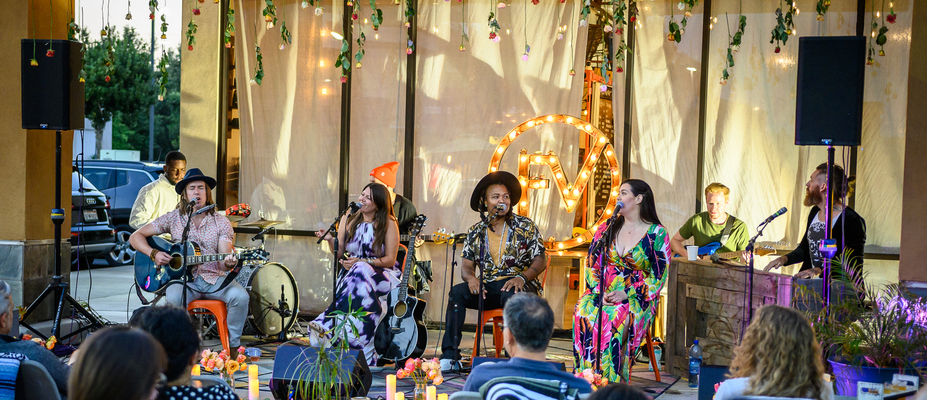Perhaps even more important than horizontal coverage is vertical coverage, where elevation and distance become critical. A large part of proper loudspeaker coverage is finding a balance between loudspeaker distance and volume. To a certain extent, having loudspeakers farther from the audience makes it easier to achieve consistent coverage, assuming you have sufficiently powerful loudspeakers and enough space to enable it.
Fill Loudspeakers
One way to get even more consistent vertical coverage is through the use of down-fill loudspeakers, which are secondary main loudspeakers (usually located in a center cluster) that point at a slightly different angle, covering a deeper section of the main audience. This allows you to cover a considerably greater area consistently.
Line arrays, which are often placed on either side of the stage, accomplish the same effect but with even greater consistency and directionality by employing several small loudspeakers, each with a narrower vertical coverage than conventional main systems.
Even with down-fill loudspeakers or line array systems, main loudspeakers can only cover so much area, and if you are planning an installation in a large venue, dealing with balconies, or running sound in large outdoor spaces, you will probably need additional loudspeakers to cover the audience. These fill-in loudspeakers can be of different types, from full-range side-fill loudspeakers placed along the edges of the audience to small balcony loudspeakers.
Delayed Loudspeakers
Any time you place loudspeakers at different distances from the audience (vertically and horizontally), you will need to delay the loudspeakers that are closer to the audience so that their arrival time at the listener is consistent with the sound coming from the main loudspeakers. The simple formula to calculate such delay time is:
Ds = (M/C) x 1000
Where Ds is the delay in milliseconds, M is the distance from the main loudspeakers in meters and C is the speed of sound of 344 m/s (at sea level, 21 degrees Celsius and under normal atmospheric conditions).
However, there is more to it. For instance, from the initial delay calculated above, fill loudspeakers are often delayed by a few extra milliseconds – taking advantage of the ‘Haas Effect’, discussed in another blog – to create the illusion that all of the sound is coming from the main loudspeakers.
Loudspeaker Vertical Coverage
Almost without exception, height is an advantage in loudspeaker placement. If they cannot be flown (which depends on the available facilities at the venue) loudspeakers should always be placed on suitable stands, rather than on tables, chairs or crates. Placing loudspeakers on stands on the venue floor is usually an important compromise, as the front rows will block the sound propagation to the rest of the audience. Installing the stands on stage, without any loudspeaker tilt, will typically places the loudspeakers’ high frequency drivers above 2.6 m (8.5 ft) from the venue floor, which is less than ideal. In addition, some venues have very low ceilings, which will compromise any vertical deployment and create strong, unwanted reflections.
The goal of consistent audience coverage is to ensure that there is no more than a 6 dB difference between the loudest and quietest points in the audience (based on the ‘Inverse Square Law’ discussed in Part II). The illustrations below show the effect of different loudspeaker positions in a typical small venue, as well as highlight different coverage scenarios. The basic rule for proper coverage is that twice the ‘green distance‘, should always be greater or equal to the ‘red distance’.
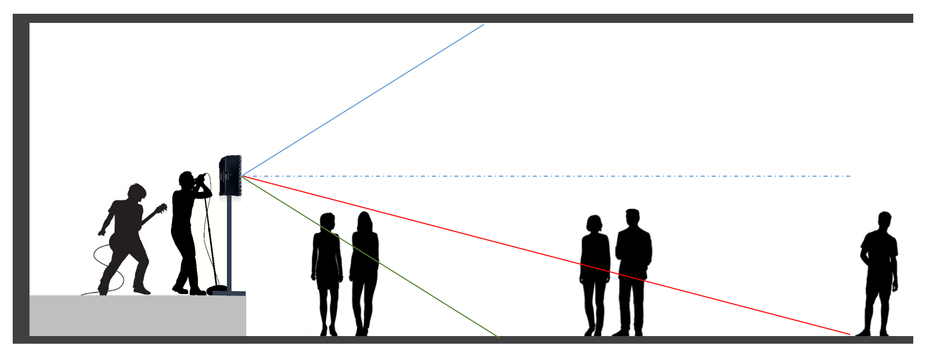
In Figure 1, with loudspeakers on stands placed on stage without any down-tilt, their on-axis energy is traveling above the entire audience at about 2.6 m (8.5 ft) from the floor. Every listener is placed off-axis from the loudspeakers, which might push the sound engineer to raise the level of the PA system. At the same time, ceiling reflected sounds increase due to the 90 degrees vertical coverage of the loudspeakers. Additionally, the reflections from the venue back wall are directly on-axis and reflect back to the stage, which can cause difficulties for the performers.
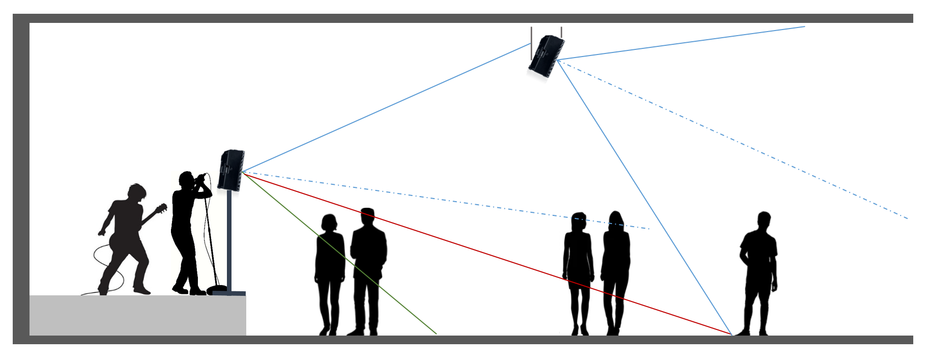
If the loudspeakers are angled downwards slightly (-7.5 degrees for the main loudspeakers in Figure 2), the coverage is improved. Loudspeakers on-axis energy is facing some part of the audience and other loudspeakers (also tilted down) are taking over the sound coverage at the point where the 6 dB difference between loudest/quietest point is exceeded (red line ending). Ceiling reflections are no longer as prominent, and the reflections from the back wall are no longer directly on-axis for the performers.
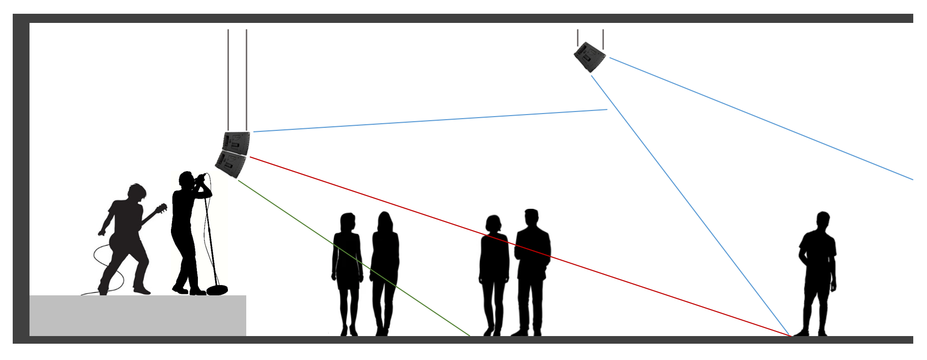
As shown in Figure 3, installing two main line array loudspeakers higher above the stage and tilted towards the audience provides further benefits. Larger parts of the listening area are now on-axis and ceiling reflections have become negligible. As in Figure 2, additional loudspeakers are taking over the sound coverage at the point where the 6 dB difference between loudest/quietest point is exceeded. Therefore, the rear part of the audience also enjoys proper sound coverage with minimal room acoustics colorations (floor reflections are usually well attenuated once the crowd fills the venue).
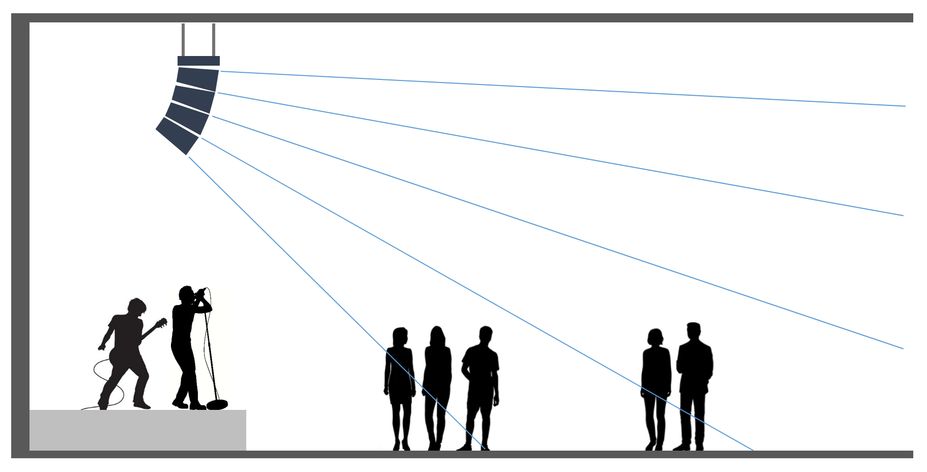
In Figure 4, four line array loudspeakers with 18 degrees vertical coverage (QSC KLA12) have been flown at ceiling height (about 5 m/16.4 ft), with a complete array down-tilt, in a larger venue. The point where the 6 dB difference between each loudspeaker’s loudest/quietest point is exceeded does not occur. The level difference across the auditorium is barely noticeable (few decibels), and the overall reverberant field is almost constant throughout. Ceiling reflections are not occurring and therefore do not degrade the sound image or color the sound from the main loudspeakers.
Conclusion
As with horizontal loudspeaker coverage, the optimum vertical coverage obviously depends on the size and shape of the venue, as well as the directivity of the loudspeakers used. However, raising the loudspeakers and angling them downwards will almost always be advantageous, and helps to get as much direct sound to the audience as possible and get the level and tone as constant as possible throughout the audience area.
So, this article is concluding our four-part series on loudspeaker placement that provided several practical tips and advice on a wide number of technical aspects once you place loudspeakers in a room. A lot of information to digest in one go. Do not hesitate to come back to this series whenever you need. Happy listening!
Christophe Anet
Latest posts by Christophe Anet (see all)
- History, Development and Applications of Column Loudspeakers - May 30, 2025
- Why is Dynamic Range so important? - May 30, 2023
- Differences between Flown and Floor-Mounted Subwoofer Deployments - May 2, 2023
